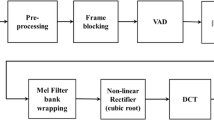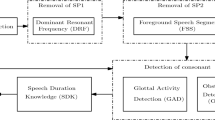Abstract
This paper presents a method for the extraction of twofold information set (TFIS) features for the text-independent speaker recognition. The method takes the Mel frequency cepstral coefficients from the frames of a sample speech signal and forms a matrix. From this, both spatial and temporal information components are derived based on the information set concept using the entropy framework. The TFIS features comprising their combination of two components are less in number thus reducing the computational time, complexity and improving the performance under the noisy environment. The proposed approach is tested on three datasets namely NIST-2003, VoxForge 2014 speech corpus and VCTK speech corpus in terms of speed, computational complexity, memory requirement and accuracy. Its performance is validated under different noisy environments at different signal-to-noise ratios.













Similar content being viewed by others
Explore related subjects
Discover the latest articles, news and stories from top researchers in related subjects.References
Aggarwal M, Hanmandlu M (2015) Representing uncertainty with information sets. IEEE Trans Fuzzy Syst 24(1):1–15
Chang C-C, Lin C-J (2011) LIBSVM: a library for support vector machines. ACM Trans Intell Syst Technol 2(3):1–27
Davis S, Mermelstein P (1980) Comparison of parametric representations for monosyllabic word recognition in continuously spoken sentences. IEEE Trans Acoust Speech Signal Process 28(4):357–366
Ephraim Y, Malah D (1984) Speech enhancement using a minimum-mean square error short-time spectral amplitude estimator. IEEE Trans Acoust Speech Signal Process 32(6):1109–1121
Furui S (1981) Cepstral analysis technique for automatic speaker verification. IEEE Trans Acoust Speech Signal Process 29(2):254–272
Hanmandlu M, Das A (2011) Content-based image retrieval by information theoretic measure. Def Sci J 61(5):415–430
Hermansky H, Morgan N (1994) RASTA processing of speech. IEEE Trans Speech Audio Process 2(4):578–589
Jawarkar NP, Holambe RS, Basu TK (2011) Use of fuzzy min–max neural network for speaker identification. In: 2011 international conference on recent trends in information technology (ICRTIT)
Jayanna HS, Prasanna SRM (2009) Multiple frame size and rate analysis for speaker recognition under limited data condition. IET Signal Proc 3(3):189–204
Jeevan M, Madasu H, Panigrahi BK (2016) Information set based gait authentication system. Neurocomputing 207:1–14
Kenny P, Boulianne G, Ouellet P, Dumouchel P (2007) Joint factor analysis versus eigenchannels in speaker recognition. IEEE Trans Audio Speech Lang Process 15(4):1435–1447
Kinnunen T, Hautamäki V, Fränti P (2006) On the use of long-term average spectrum in automatic speaker recognition. In: 5th international symposium on chinese spoken language processing (ISCSLP’06). Singapore, pp 559–567
Kumar K, Kim C, Stern RM (2011) Delta-spectral cepstral coefficients for robust speech recognition. In: IEEE international conference on acoustics, speech and signal processing (ICASSP)
Lee KY (2004) Local fuzzy PCA based GMM with dimension reduction on speaker identification. Pattern Recogn Lett 25(16):1811–1817
Longworth C, Gales MJF (2009) Combining derivative and parametric kernels for speaker verification. IEEE Trans Audio Speech Lang Process 17(4):748–757
Madasu H (2011) Information sets and information processing. Def Sci J 61(5):405–407
Mak MW, Pang X, Chien JT (2016) Mixture of PLDA for noise robust i-vector speaker verification. IEEE/ACM Trans Audio Speech Lang Process 24(1):130–142
Mamta B, Madasu H (2014a) A new entropy function and a classifier for thermal face recognition. Eng Appl Artif Intell 36:269–286
Mamta B, Madasu H (2014b) Robust authentication using the unconstrained infrared face images. Expert Syst Appl 41(14):6494–6511
Mandasari MI, Mitchell ML, van Leeuwen DA (2011) Evaluation of i-vector speaker recognition systems for forensic application. In: INTERSPEECH
Markel J, Oshika B, Gray A (1977) Long-term feature averaging for speaker recognition. IEEE Trans Acoust Speech Signal Process 25(4):330–337
[Online] (2003) The NIST year 2003 speaker recognition evaluation plan. http://www.itl.nist.gov/iad/mig/tests/sre/2003/2003-spkrec-evalplan-v2.2.pdf
[Online] (2009) The Centre for Speech Technology Research VCTK Corpus
[Online] (2015) VoxForge speech corpus. http://www.repository.voxforge1.org/downloads/SpeechCorpus/Trunk/Audio/Main/
Pelecanos J, Sridharan S (2001) Feature warping for robust speaker verification. A speaker odyssey—the speaker recognition workshop. Crete, Greece, International Speech Communication Association (ISCA), pp 213–218
Pinheiro HNB, Vieira SRF, Ren TI, Cavalcanti GDC, de Mattos NPSG (2016). Type-2 fuzzy GMM for text-independent speaker verification under unseen noise conditions. In: 2016 IEEE international conference on acoustics, speech and signal processing (ICASSP)
Pujol P, Macho D, Nadeu C (2006). On real-time mean-and-variance normalization of speech recognition features. In: 2006 IEEE international conference on acoustics speech and signal processing proceedings
Reynolds DA (1995) Speaker identification and verification using Gaussian mixture speaker models. Speech Commun 17(1–2):91–108
Reynolds DA, Rose RC (1995) Robust text-independent speaker identification using Gaussian mixture speaker models. IEEE Trans Speech Audio Process 3(1):72–83
Reynolds DA, Quatieri TF, Dunn RB (2000) Speaker verification using adapted Gaussian mixture models. Digit Signal Proc 10(1–3):19–41
Lung S-Y (2004a) Adaptive fuzzy wavelet algorithm for text-independent speaker recognition. Pattern Recogn 37(10):2095–2096
Lung S-Y (2004b) Further reduced form of wavelet feature for text independent speaker recognition. Pattern Recogn 37(7):1565–1566
Sohn J, Kim NS, Sung W (1999) A statistical model-based voice activity detection. IEEE Signal Process Lett 6(1):1–3
Togneri R, Pullella D (2011) An overview of speaker identification: accuracy and robustness issues. IEEE Trans Circuits Syst Mag 11(2):23–61
Wan V, Renals S (2005) Speaker verification using sequence discriminant support vector machines. IEEE Trans Speech Audio Process 13(2):203–210
Wang Y, Liu X, Xing Y, Li M (2008) A novel reduction method for text-independent speaker identification. In: 2008 fourth international conference on natural computation
Zhao X, Wang DL (2013). Analyzing noise robustness of MFCC and GFCC features in speaker identification. In: IEEE international conference on acoustics, speech and signal processing (ICASSP)
Mirhassani SM, Ting H-N (2014) Fuzzy-based discriminative feature representation for children’s speech recognition. Digital Signal Process 31:102–114
Yuan ZX, Yu CZ, Fang Y (1993) Text independent speaker identification using fuzzy mathematical algorithm. In: IEEE international conference on acoustics, speech, and signal processing, ICASSP
Zadeh LA (1965) Fuzzy sets. Inf Control 8(3):338–353
Zhao X, Shao Y, Wang DL (2012) CASA-based robust speaker identification. IEEE Trans Audio Speech Lang Process 20(5):1608–1616
Acknowledgements
This is a part of the ongoing project on “Personal Authentication using Multimodal Behavioral Biometrics: Voice and Gait” and the authors express their gratitude to the Department of Science and Technology, Government of India (Grant No. SB/S3/EECE/0127/2013) for funding the project.
Author information
Authors and Affiliations
Corresponding author
Ethics declarations
Conflict of interest
The authors’ declare that they have no conflict of interest.
Human and animals rights
This article does not contain any studies with direct human participants or animals performed by any of the authors.
Additional information
Communicated by V. Loia.
Publisher's Note
Springer Nature remains neutral with regard to jurisdictional claims in published maps and institutional affiliations.
Rights and permissions
About this article
Cite this article
Medikonda, J., Bhardwaj, S. & Madasu, H. An information set-based robust text-independent speaker authentication. Soft Comput 24, 5271–5287 (2020). https://doi.org/10.1007/s00500-019-04277-9
Published:
Issue Date:
DOI: https://doi.org/10.1007/s00500-019-04277-9




